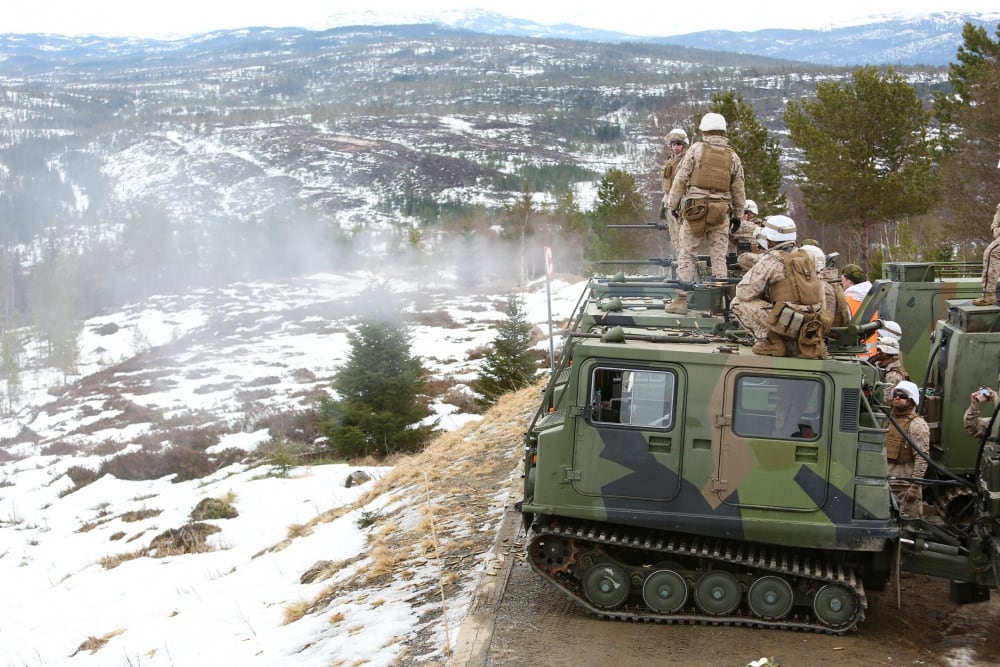The top Marine has been steadily increasing the Corps’ footprint in the arctic region, preparing Marines for a fight in extreme cold-weather environments as the U.S. defense strategy shifts toward near-peer threats.
It’s an oft repeated remark by Commandant Gen. Robert B. Neller that the cold weather business is something the Corps hasn’t done for some time.
And it certainly shows in some of the equipment the Corps uses in Norway, like the nearly 40-year-old Cold War relic over-the-snow vehicle, the Bv206.
The Corps has been rapidly replacing its cold-weather gear to include skis, pack frames, boots and shelters. And now, a new over-the-snow vehicle could be on the horizon for the Marines.
One potential replacement for the aging Bv206 could be BAE’s BvS10, which is already in use by Marines in Norway, who have been training on the British variant of the BvS10 known as the Viking.

The BvS10, while predominantly suited for the Arctic region, is actually an all-terrain vehicle that can also traverse mud, swamp, gravel or even water.
The tracked vehicle, which can carry 11 to 12 troops, has a ground pressure less than the human foot, according to Keith Klemmer, BAE’s U.S. BvS10 representative. The low ground pressure spread across the tracks gives the vehicle superior mobility in a multitude of terrains, especially snow.
And for military operations, the BvS10 can mount the Ma Deuce .50 caliber machine or even the Common Remotely Operated Weapon Station, which affords troops the ability to engage targets from the protections and confines of the vehicle.
Speaking of protection, the armor plating on the BvS10 can withstand small-arms fire and the RPG-7, Klemmer said.
The Bv-S10 can operate in temperatures ranging from -50 to 120 degrees Fahrenheit and boasts an impressive range of nearly 200 miles, according to Klemmer.
While the Corps is prepping for its fourth six-month rotation to Norway, it’s only been recently that the Corps and the U.S. military has once again focused on the Arctic and European theaters.
For the past twenty years, the desert terrain of the Middle East has garnered the attention of the Corps and as a result, the military’s fleet of over-the-snow vehicles have taken a back seat in priority.
But with a renewed spotlight on the Arctic region, and a Marine footprint that is expected to double in Norway in the coming months, the time may be ripe to upgrade the Corps’ suite of snow vehicles.
And the U.S. military is showing interest.
In early June, the Army posted a request for information, or RFI, to industry leaders for what it has dubbed the Joint All Weather All Terrain Support Vehicle, or JAASV.

According to the RFI, the Army wants its future tracked snow vehicle to operate in temperatures between -50 and 115 F. And the Army wants a multi variant vehicle that can carry troops, serve as an ambulance, or a command system.
The BvS10 fits much of that description. The main cab can serve as a command node, while the back cab can transport nearly eight troops. The rear cab also has the ability to flip up and serve as an ambulatory vehicle.
“The JAASV shall be a tracked vehicle that has excellent on and off-road mobility in extreme cold temperatures, deep snow, rugged uneven terrain, thick brush or forest, soft wet ground, rivers, streams, and lakes, and mountainous terrain,” the RFI reads.
The Army also wants the JAASV to be air mobile by CH-47, UH-60 and C-130.
And while this RFI was submitted by the Army, the Corps has a tracked record of partnering with the Army on a number of procurement projects.
The Corps hasn’t made a decision yet to upgrade its snow vehicles, but the Marines are increasingly becoming focused on the Arctic domain and its forces are already learning how to operate partner forces’ BvS10s in the region.
Shawn Snow is the senior reporter for Marine Corps Times and a Marine Corps veteran.




